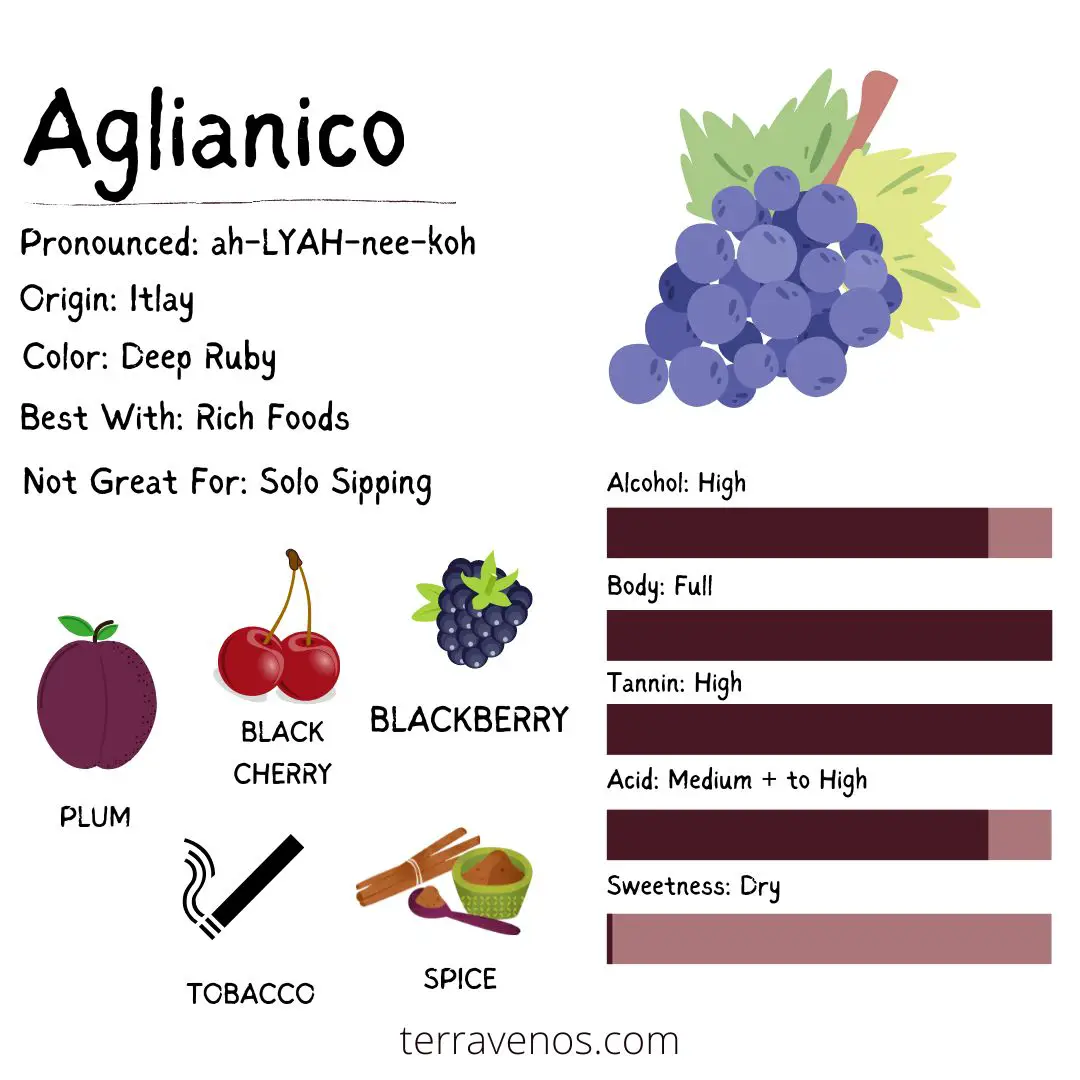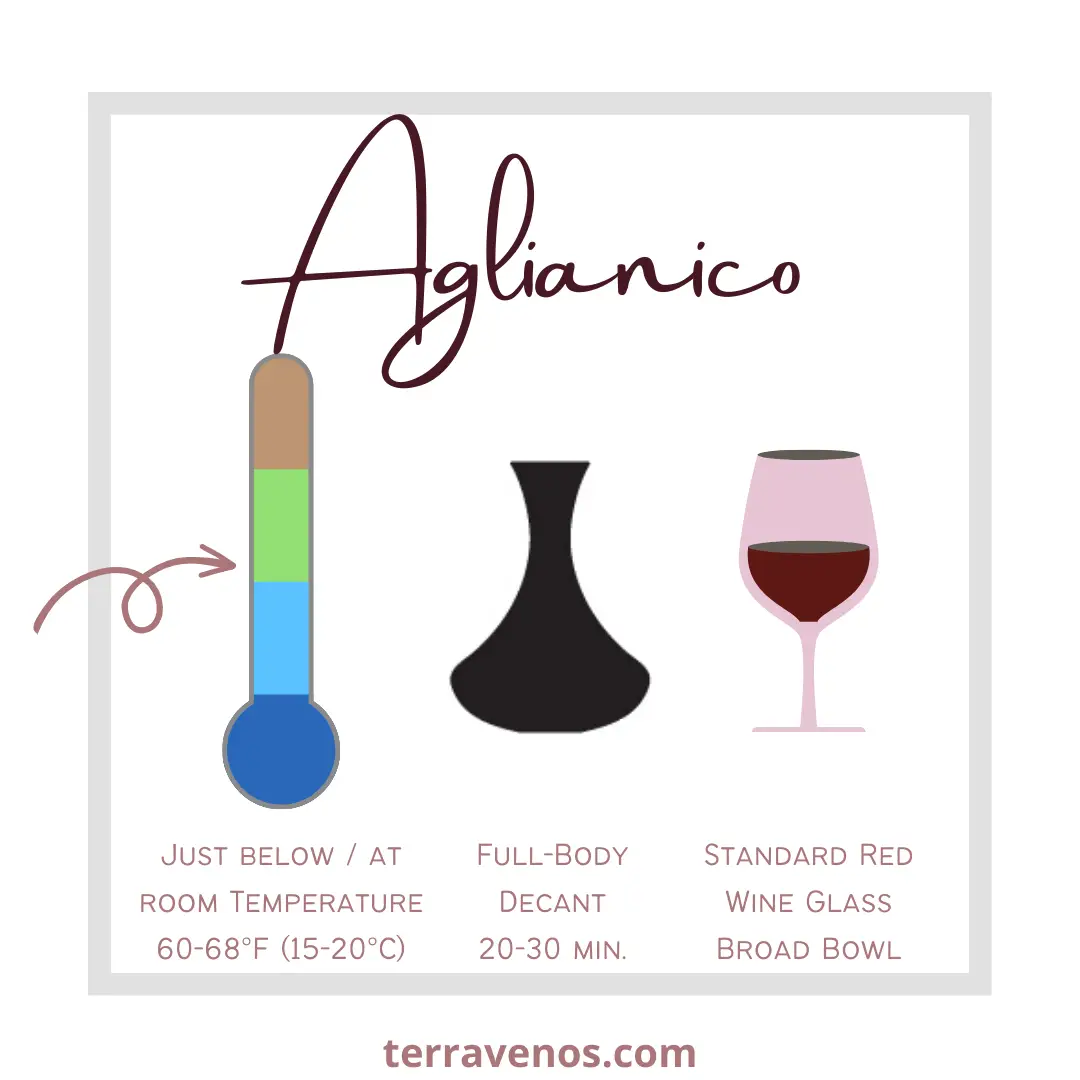
Pronunciation: ah-LYAH-nee-koh
Aglianico is a red wine grape originally from Italy. Widely used in blends and as a single varietal, Aglianico produces a robust, full-bodied dry red wine with notes of blackberry, dark cherry, spices, and a hint of leather.
What Kind of Wine is Aglianico?
Aglianico is a full-bodied red wine with high acidity, pronounced tannins, and elevated alcohol content. Its style typically falls between Merlot and Cabernet Sauvignon.
Where Does Aglianico Wine Come From?
Originating from south-central Italy, particularly Campania and Basilicata, Aglianico has a deep connection to the region’s winemaking traditions. It is a prominent grape in wines from Taurasi and Aglianico del Vulture.
Aglianico in Campania
In Campania, Aglianico is a leading grape variety, producing wines with bold character and structure. The Taurasi DOCG, known as the “Barolo of the South,” features Aglianico as the primary grape.
Aglianico in Basilicata
In Basilicata, Aglianico is the star grape in the Aglianico del Vulture DOC. Here, the volcanic soils contribute to wines with intense flavors and a distinct sense of terroir.
Helpful Wine Buying Tip: Look for wines labeled Aglianico del Vulture or Taurasi for an authentic Aglianico experience.
Other Notable Aglianico Growing Regions
Outside of Italy, Aglianico is gaining recognition. Some California winemakers incorporate Aglianico, adding a unique touch to their blends. The grape is also making strides in Australia, Argentina, and Texas.
What Does Aglianico Smell Like?
Aglianico is characterized by a robust aroma, often featuring dark fruit notes such as blackberry and black cherry. Additionally, you might detect hints of spices, leather, and a subtle earthiness.
Fun Wine Fact: Did you know that Aglianico is sometimes referred to as the “Barolo of the South” due to its rich and complex nature?
What Does Aglianico Taste Like?
Aglianico adapts well to various climates, producing wines with a range of flavors. In warmer regions, you can expect bold and ripe black fruit flavors, while cooler climates may yield more vibrant and acidic profiles.
On the palate, Aglianico boasts a firm structure with lively acidity and pronounced tannins. While the tannins can be bold, they generally don’t reach the intensity of Cabernet Sauvignon.
Helpful Tip: Here’s a 30-second tasting tip on how to taste wine tannins.
Personal Note: I always find that Aglianico tends to be more robust and intense than other Italian red varietals, certainly more so than Sangiovese.
Is Aglianico a Heavy Wine?
Aglianico wines can range from medium to full-bodied. Wines with higher alcohol content (above 14% ABV) tend to be more robust and full-bodied.
How to Serve Aglianico Wine

Temperature
Serve Aglianico slightly below room temperature, around 60-68°F (15-20°C). This allows the wine to breathe while maintaining a refreshing quality.
Glassware
Opt for a standard red wine glass with a broad bowl to enhance aeration and concentrate aromas.
Decanting
Lighter Aglianico styles may need minimal decanting, while more complex wines benefit from 20-30 minutes to fully develop. If the wine seems closed, let it sit for 10 minutes and revisit.
Aging Potential
Aglianico evolves beautifully with age, becoming more complex. Lighter styles can improve over 2-5 years, while fuller-bodied versions can age for 5-10 years or more.
What Is Aglianico Similar To? Syrah and Nebbiolo
Aglianico shares some characteristics with Syrah and Nebbiolo. Its boldness and structured tannins are reminiscent of Syrah, while its aging potential and complex nature draw parallels to Nebbiolo.
| Feature | Aglianico | Syrah (Shiraz) | Nebbiolo |
|---|---|---|---|
| Origin | Southern Italy (Campania and Basilicata) | Rhône Valley (France) and Australia | Piedmont (Italy) |
| Climate | Hot and arid climates | Diverse climates, adaptable | Continental with cool temperatures |
| Soil Preference | Volcanic soils, limestone, clay | Various soils, well-drained preferred | Calcareous, sandy, and clay soils |
| Wine Styles | Full-bodied, tannic red wines | Full-bodied, bold and spicy | Medium to full-bodied, high acidity |
| Tannins | High tannins | Moderate to high tannins | High tannins, refined |
| Acidity | High acidity | Moderate to high acidity | High acidity, crisp |
| Flavors | Dark fruits, black cherry, earthy | Dark fruits, blackberry, peppery | Red fruit, rose, tar, truffle |
| Aging Potential | Excellent aging potential | Good aging potential | Excellent aging potential |
| Food Pairing | Grilled meats, rich stews, hard cheeses | Grilled meats, barbecue, spicy dishes | Braised meats, truffle-based dishes |
Aglianico Synonyms
Aglianico is known by various names, including Aglianco di Puglia, Aglianica, Aglianica De Pontelatone, Aglianichella, Aglianichello, Aglianico Amaro, Aglianico Comune, Aglianico Crni, Aglianico del Vulture, Aglianico di Benevento, Aglianico di Castellaneta, Aglianico di Lapio, Aglianico di Taurasi, Aglianico Femminile, Aglianico Liscio, Aglianico Mascolino, Aglianico Nero, Aglianico Noir, Aglianico Pannarano, Aglianico Trignarulo, Aglianico Tringarulo, Aglianico Verase, Aglianico Zerpoluso, Aglianico Zerpuloso, Aglianicone, Aglianicuccia, Agliano, Agliantica, Agliatica, Agliatico, Agnanico, Agnanico di Castellaneta, Alianiko, Cascavoglia, Cassano, Cerasole, Ellanico, Ellenica, Ellenico, Fiano Rosso, Fresella, Gagliano, Gesualdo, Ghiandara, Ghianna, Ghiannara, Glianica, Gnanica, Gnanico, Granica, Granico, Hellanica, Malvasia, Olivella, Olivella di San Cosmo, Pie di Colombo, Prie Blanc, Ruopolo, Spriema, Tintora, Tintora di Cerinola, Tringarulo, Uva Aglianica, Uva Castellaneta, Uva dei Cani, Uva di Castellaneta, Uva Nera, Zuccherina.
Aglianico Food Pairing Suggestions

Aglianico’s versatility makes it a fantastic companion for an array of dishes. Pair it with hearty meats, grilled vegetables, or aged cheeses to complement its robust character.
Quick Tips: Aglianico Food Pairing
- Grilled lamb chops with rosemary
- Portobello mushroom risotto
- Aged Parmesan or Pecorino cheese
Aglianico vs. Other Varietals
While Aglianico shares some characteristics with Cabernet Sauvignon, it stands out with its distinctive intensity and bold structure. In comparison to Sangiovese and other Italian varietals, Aglianico’s rich and complex profile sets it apart.
Notable Aglianico Producers and Bottles to Try
When exploring Aglianico, seek out producers dedicated to this grape. Notable wineries include:
- Feudi di San Gregorio (Campania, Italy)
- Paternoster (Basilicata, Italy)
- D’Angelo (Basilicata, Italy)
Fun Wine Fact: Aglianico can be crafted into sweet dessert wines, or passito wines. If you have the chance to try this style, go for it!
Sustainable Practices in Aglianico Vineyards
Today, sustainable viticulture plays a crucial role in Aglianico production. Many vineyards adopt organic and biodynamic practices, promoting environmental health and preserving the grape’s unique characteristics. Aglianico’s love for warm dry growing sites lends itself to organic viticulture where there’s less disease pressure.
Final Thoughts – Aglianico as Must-Try Red Wine Varietal
With its bold flavors, structured profile, and aging potential, Aglianico is a red wine varietal worth exploring. Here are three key takeaways:
- Distinctive Flavor Profile: Aglianico offers a rich palate of dark fruits, spices, and earthy undertones.
- Food-Friendly: Pair Aglianico with robust dishes to enhance its intensity, making it a versatile choice for food pairing.
- Regional Diversity and Aging Potential: Explore Aglianico wines from different regions to appreciate the diversity and aging potential.
Thirsty for More?
Discover more intense red wines with our list of bold red wines from around the world.
Here’s how to use Italy’s wine classification system to pick winning wines.



